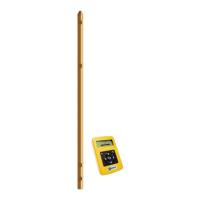MANUAL – REFLEX EZ-TRAC™ | 12
4 Working Principles
This chapter describes the working principles of magnetic instruments
from
REFLEX™.
4.1 Introduction
REFLEX™ magnetic instruments provide survey results of azimuth,
dip, magnetic field strength, magnetic dip, gravity, gravity tool face,
magnetic tool face and temperature.
Azimuth is measured with magnetometers. Based on data from the
magnetometers, the direction of the instrument relative to the Earth’s
magnetic field is calculated.
Dip and roll angle (gravity tool face) are measured with
accelerometers. Based on data from the accelerometers, the direction
of the instrument relative to the Earth’s gravitational field is
calculated.
Based on data from the magnetometers and the accelerometers, the
total magnetic field strength and the magnetic dip are also calculated.
An electronic temperature sensor measures the temperature.
4.2 Magnetism
The Earth is surrounded by an invisible force – the geomagnetic field.
The magnetic field originates deep within the Earth, and extends far
out into space. The geomagnetic field is approximately directed from
south to north, and changes constantly in direction and strength.
4.2.1 Magnetometers
The instrument probe contains three fluxgate magnetometers aligned
in orthogonal directions. The magnetometers register the local
geomagnetic field and provide the horizontal component (the
azimuth) relative to the magnetic north.
A fluxgate magnetometer is based on the saturation of magnetic
materials, and this is how it works:
A typical electromagnet has an iron core with a coil around it. The
magnetic atoms of the iron substantially strengthen the magnetic field
of the coil.
The magnetic axes of the atoms in ordinary iron point in random
directions. The sum of their magnetic fields is close to zero. But,
when an electric current flows in the coil, the magnetic field - which is
generated by the current - forces the magnetic axes of the iron atoms
to line up with and strengthen the magnetic field created by the
current.
However, when all atoms are lined up, the iron core cannot contribute
to the magnetic field any more. This state is called the saturation
magnetisation of the iron. If the electric current is increased in the
coil, the magnetic field only increases by the amount due to the
current itself, without any help from the iron core.
There are materials where the saturation happens suddenly,
completely and at a well defined level. If a core of such material is

